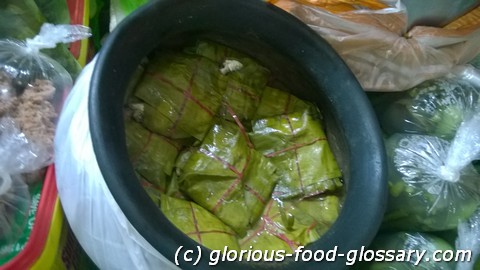Deutsch: Pinais na Isda / Español: Pinais na Isda / Português: Pinais na Isda / Français: Pinais na Isda / Italiano: Pinais na Isda
Pinais na Isda is a traditional Filipino dish that involves wrapping fish or shrimp in banana leaves with a mixture of coconut milk, garlic, ginger, and sometimes other ingredients like tomatoes or chili peppers. The wrapped fish is then steamed or grilled, allowing the flavors to infuse into the seafood while keeping it moist and tender. This cooking method not only imparts a distinct aroma and flavor but also preserves the fish, a technique deeply rooted in Filipino culinary tradition.
Description
The term "Pinais" refers to the method of cooking in banana leaves, a practice common in Southeast Asian cuisines for its ability to add a subtle, aromatic flavor to food while retaining moisture. Pinais na Isda showcases the simplicity and ingenuity of Filipino cooking, emphasizing the use of fresh, local ingredients. The dish is a favorite in regions abundant in coconut and where seafood is a staple, reflecting the country's tropical climate and extensive coastline.
Application Areas
Pinais na Isda is popular in coastal areas of the Philippines, particularly in regions where fresh seafood and coconut are readily available. It's a common dish in home cooking and is also served in Filipino restaurants specializing in traditional cuisine. Additionally, it's a celebrated part of culinary festivals and special occasions, highlighting the Philippines' rich seafood culture.
Well-Known Examples
While Pinais na Isda itself is a specific dish, variations exist across the Philippines, each with its unique twist depending on the type of fish or ingredients used. In some regions, small fish like anchovies are used to make Pinais, while in others, larger fish like tilapia or milkfish are preferred. Similarly, the dish "Pinais na Hipon" uses shrimp instead of fish but follows a similar preparation method.
Treatment and Risks
Pinais na Isda is considered a healthy dish due to its use of fresh ingredients and minimal oil. The banana leaves not only impart flavor but also create a steamy environment that cooks the fish gently, preserving its nutrients. However, as with any seafood dish, freshness is crucial to avoid the risk of foodborne illnesses. Ensuring that the fish is fresh and properly cleaned before cooking is essential for both safety and quality.
Recipes
Simple Pinais na Isda Recipe:
Ingredients:
- 2 medium-sized fish (tilapia, mackerel, or any firm white fish), cleaned and gutted
- 1 cup coconut milk
- 2 cloves garlic, minced
- 1 small ginger, julienned
- 2 tablespoons vinegar
- Salt and pepper to taste
- Banana leaves for wrapping
- String or toothpicks to secure the wraps
- Season the fish with salt and pepper inside and out.
- In a bowl, mix the coconut milk, garlic, ginger, and vinegar. Season with a little salt and pepper to taste.
- Place each fish on a piece of banana leaf large enough to wrap it completely. Pour half of the coconut milk mixture over each fish.
- Wrap the fish securely in the banana leaf, folding the edges to seal. Use string or toothpicks to keep the wrap closed.
- Steam or grill the wrapped fish for about 20-30 minutes, depending on the size of the fish, until cooked through.
- Carefully unwrap the banana leaves and serve the fish hot, ideally with rice and a side of fresh vegetables.
Similar Terms or Synonyms
In Filipino cuisine, "Pinais" can refer to any dish that involves wrapping and cooking ingredients in banana leaves, not limited to fish. Similar cooking techniques are found in other Southeast Asian cuisines, where wrapping food in banana leaves is a common practice.
Summary
Pinais na Isda is a cherished Filipino culinary tradition, highlighting the natural bounty of the Philippines' seas and land. The combination of fresh fish, coconut milk, and the aromatic infusion from banana leaves creates a flavorful, nutritious dish that reflects the essence of Filipino home cooking. It's a testament to the country's ability to transform simple ingredients into a memorable meal, rooted in the practices of preservation, flavor, and communal eating.
--

Related Articles to the term 'Pinais na Isda' | |
| 'Buto' | ■■■■■■■■■■ |
| Buto is the Filipino word for bones or seeds. buto ng pakwan watermelon seed buto ng kalabasa squash . . . Read More | |
| 'Ginataang Papaya' | ■■■■■■■■■■ |
| Ginataang Papaya in the food context refers to a traditional Filipino dish where unripe papaya is cooked . . . Read More | |
| 'Ginataang Santol at Hipon' | ■■■■■■■■■■ |
| Ginataang Santol at Hipon in the food context refers to a traditional Filipino dish that combines santol . . . Read More | |
| 'Relyenong Pusit' | ■■■■■■■■■■ |
| Relyenong Pusit refers to a traditional Filipino dish that consists of stuffed squid. The squid is cleaned . . . Read More | |
| 'Moron' | ■■■■■■■■■■ |
| Moron . . . . . . Read More | |
| 'Kulawong Talong' | ■■■■■■■■■■ |
| Kulawong Talong in the food context refers to a traditional Filipino dish made from grilled or smoked . . . Read More | |
| 'Pasingaw' | ■■■■■■■■■■ |
| Pasingaw is a Filipino term which means steaming fish, shellfish or meats. It is also know as pasingawan. . . . Read More | |
| 'Ginisang Labong' | ■■■■■■■■■■ |
| Ginisang Labong in the food context refers to a Filipino dish made from sautéed bamboo shoots, known . . . Read More | |
| 'Indonesian' | ■■■■■■■■■■ |
| Indonesian cuisine represents the culinary traditions of Indonesia, an archipelago that consists of thousands . . . Read More | |
| 'Kinilaw na Isda' | ■■■■■■■■■ |
| Kinilaw na Isda in the food context refers to a traditional Filipino dish similar to ceviche, consisting . . . Read More | |
